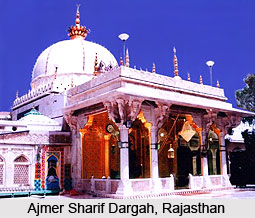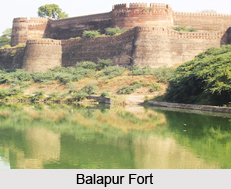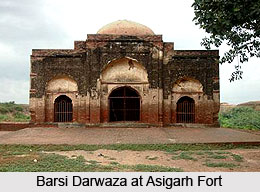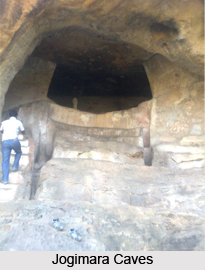Islamic art in Western India encompasses various kinds of Islamic architecture and several other forms of art which thrived in the Western Indian states like Rajasthan, Gujarat and Maharashtra. Mosques, shrines, `dargahs`, royal palaces and many other instances of Islamic arts are exhibited through these manifold beautiful Islamic arts in these regions of the country. Many of the Islamic Monuments have acquired features of local architectural styles and characteristics of different religious styles.
 Islamic Art in Rajasthan
Islamic Art in Rajasthan
The Ajmer Sharif Dargah in Rajasthan, which is the tomb of the Sufi saint Khwaja Moin-ud-din Chishti is visited by a vast quantity of devotees belonging to all religions, every year. The place is quite revered since devotees believe that visiting this holy shrine leads to the fulfillment of the desires and wishes of the visitors. `Urs` fair is celebrated every year to commemorate the six days of prayers during which this Persian saint had prayed near this place. This saint is said to be the founder of the `Sufi` sect at Ajmer. This shrine is considered the best specimen of Islamic art in the state. Apart from this, the `Adhai din ka Jhonpra` mosque is another brilliant example of Islamic architecture here. As suggested by its name, the construction of this mosque was completed within two and a half days. The mosque is skillfully decorated with arches embellished with intricate designs of Islamic calligraphy. Star-shaped minarets surround the Adhai din ka Jhopra mosque.
Miyan Bai`s mosque built on the models of the architecture patronized by Shah Jahan, is yet another impressive structure of Islamic arts in Rajasthan. Rajasthan boasts of a famous `chilla khana`, the house of meditation of a popular saint known as Miun ud-Din which he inhabited till his death is another center of Islamic arts. Nagaur district in Rajasthan possesses Kachehri Mosque which was erected by Muhammad Sharif Quraishi in 1638 following royal orders, which is also well-known for its Islamic architecture.
Islamic Arts in Gujarat
Sidi Bashir Mosque in Ahmedabad, which is also referred to as `Jhulta Minar` or `Shaking Minarets` is extremely popular throughput India due to its unique style of Islamic architecture. It was constructed by Sidi Bashir who was a slave of Sultan Ahmed Shah in the year 1452. It is said that if one of the minarets tremble slightly, the second minaret also vibrates for a few seconds, though the passage between them is devoid of any vibration.
Islamic Art in Maharashtra
The Aurangabad region of Maharashtra is complete with magnificent pieces of Islamic arts which have been introduced since the arrival of the Delhi Sultanate in the nation. Bibi Ka Maqbara located at this place is a reputable Islamic art form in the state.
Islamic arts in Western parts of India attract millions of visitors throughout the year, particularly the Ajmer Sharif Dargah in Rajasthan, Islamic structures in Aurangabad, Maharashtra and numerable other forms of Islamic art are immensely popular not only in the country, but also globally.




